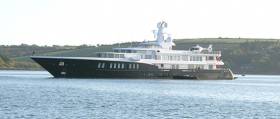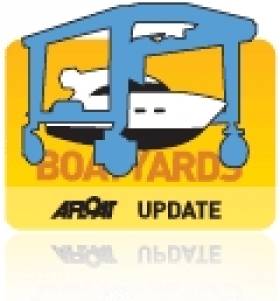Displaying items by tag: Super yacht
Wally’s Latest Full-Custom 101-ft Cruiser-Racer Emerges From the Moulds
Wally’s latest bespoke sailing creation has just passed a crucial construction milestone with the demoulding of the hull. The sleek carbon hull of the new 101-foot cruiser-racer was lifted out of its female mould. She is the fourth Wally for an experienced owner and inspired by the Wallycento box rule.
It is rare for one-off yachts at this scale to use female moulding, which is time-consuming to build. But the company says it was the right decision because a female mould ensures a near-perfect exterior finish. As a result, very little filler was needed to fair the hull, further eliminating unnecessary hull weight – a critical part of the owner’s brief.
It is still a heart-stopping moment in any big full-carbon boatbuilding project when the hull is revealed for the first time. The lines and exterior form are seen at last, and the quality of the construction is laid bare for all to see. Being a Wally, with minimal, flowing lines and easy power in its DNA, the new 101 was under intense scrutiny – something she bore with ease.
“This is the moment in the birth of a boat when her concept takes material shape for the first time and you get a glimpse of the vessel she will become. It is thrilling to watch,” says Wally Managing Director Stefano
de Vivo. “In this case, her purposeful bow and powerful lines promise exhilarating performance and spellbinding looks.”
Built using advanced pre-preg carbon fibre in a sandwich composite, the Wally 101 weighs just 56 tonnes.
That is some 20 per cent less than yachts of similar size and capabilities and comes in spite of a host of labour-saving technology. This includes Wally’s Magic Trim and Magic Traveller hydraulic systems.
Astonishingly, 40 per cent of her weight is from the lifting keel alone, promising eye-watering performance.
After demoulding, the hull was laid in a cradle and moved back undercover for the next stage of its transformation. Shipwrights are already installing the bulkheads that will divide up the interior space, with wiring, piping, tanks and other engineering foundations while the lightweight carbon deck is currently in mould.
National Maritime College of Ireland Steers a Course for Superyacht Success
In a move to broaden the base of its operations even further, and capitalise on the ever growing global Superyacht market, the National Maritime College of Ireland (NMCI) has made significant investments in developing its course programmes for this exciting sector. That investment paid dividends as the College’s new Superyacht Division has secured approval from the Private Yachting Association (PYA) to complement its existing programmes for deck and engine crew right up to Masters Qualification.
Joey Meen, PYA Director, CEO GUEST Programme said,“We are delighted to announce that the NMCI is now a GUEST accredited Training Provider offering the introduction levels of the GUEST programme. NMCI have easily met the required standards for approval under the PYA GUEST Guidelines offering huge value to the students with their professional facilities and qualified trainers.
NMCI staff and trainers are committed to ensuring that their students training for interior yacht crew positions have the continued support and relevant education they need. The training offered will give confidence and skills sets to enhance individual careers as well as bringing value to the interior departments on-board.
NMCI are now one of the 20 plus GUEST accredited training providers worldwide, who will be working with us to maintain standards of education and learning outcomes for the students’ investment. They are very much welcomed into the GUEST entity and we look forward to working with them in the years to come."
Jim O’Byrne, Head of NMCI Services continued, “This recent PYA approval was the final link in the chain to enable us to offer qualified Irish citizens out in to the Private Yacht arena, and to facilitate the existing cohort of seafarers currently enjoying employment in this sector”
CIT President, Dr Barry O’Connor, congratulated the team at the NMCI for once again securing international recognition and validation for the high standards and on-going relevance of the education and training programmes being offered. The NMCI has once again identified, and effectively responded to, the needs of a growing niche area in the maritime sector. Such successes secure the positive future of the NMCI and sustain the established reputation of Cork Institute of Technology as a responsive and agile institution identifying and serving specific evolving needs of enterprise and of communities generally.
The world’s largest privately owned yacht sailed into Cork harbour yesterday. The majestic Eos is named after the ancient Greek goddess. Owned by American media and television executive Barry Diller, the Eos is is a three-masted Bermuda rigged schooner. It is 93 metres long, weighs 1,500 tonnes and its three masts are 61m high.
Eddie English saw her quayside in Cobh yesterday and posted this video:
Meanwhile a second Superyacht is calling to Cork this afternoon, the ‘Galileo G’. It is a 55m Perini Navi ice class steel displacement hull built in 2011, British flagged and has accommodation for 10 guests and 12 crew. It is powered by two caterpillar engines with a cruising speed of 11 knots giving it a range of 9,000 nautical miles.
The hull design is from Philippe Briand and the exterior design is from the Vitruvius series.
‘It is great to see boats of this calibre now becoming regular visitors to the area', said Kinsale based John McDonald of MGM Boats.
131–ft Super Yacht Dropped During Cargo Ship Lift
#superyachtdrop – Time to check your insurance policy! This 131ft superyacht was being hoisted on a container vessel in the port of Colon in Panama on Tuesday.
However, this routine procedure went wrong when the lifting straps around the superyacht broke, dropping the vessel onto the deck as the vid above shows (at about 0.48 seconds on the timeline).
Eddie Jordan's New 155–foot Sunseeker Super Yacht Nears Completion
#sunseeker – Is this the biggest boat owned by an Irishman? Sunseeker's largest ever yacht for Irish Formula One mogul Eddie Jordan has been revealed this weekend at Poole Quay in Dorset, the Bournemouth Echo reports.
The 155–foot yacht, reported to be worth £32 million, was painstakingly moved out of the shed by Sunseeker staff on Saturday and took more than an hour to move the short distance into the yard.
Eddie Jordan has been enjoying a lot of time on the ocean waves of late. Afloat previously reported (this time last year) on the start of Jordan's Round the World Rally. He was joined on that voyage by Dun Laoghaire sailing school instructor Paul Adamson on the Oyster 885, Lush, for the first ever Oyster World Rally.
Meanwhile in Poole, Stewart McIntyre, Managing Director at Sunseeker, whose Irish agents are MGM Boats in Dun Laoghaire, said yesterday: "This is an extremely exciting time for Sunseeker as we inch ever closer to the completion of the 155 Yacht.
"This is the biggest project we have ever undertaken and since the announcement of its build it has been the talk of the industry.
"We are incredibly proud of what we have created and look forward to showcasing it to the world."
The impressive accommodation can cater for 12 guests and 10 crew, and has an on board nightclub, a panoramic viewing area, a dining area, bar and its own garage for jet skis.
The largest luxury boat ever built by the company had to be moved using a radio controlled multiple wheeled unit from its build shed onto the quay at Poole for the final fitting out.
An extra radar mount was needed to complete the boat but it was far too tall for the current shed so the boat will have to spend at least one or two more weeks on the harbourside before it can be finally launched into the water.
More from the Bournemouth Echo here
































































